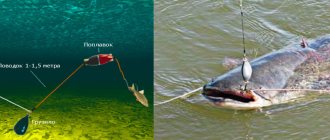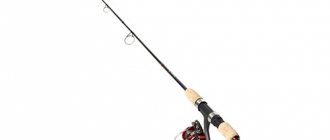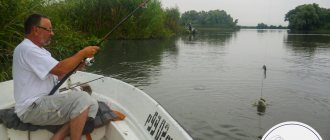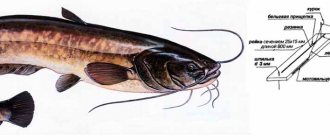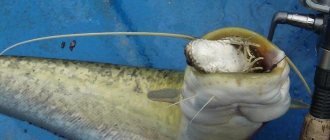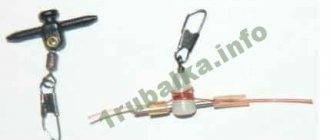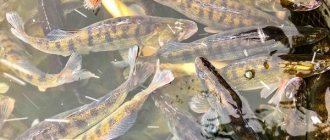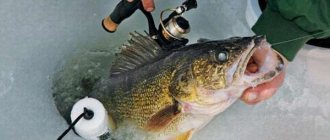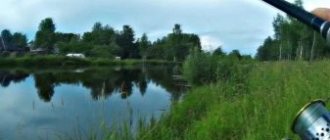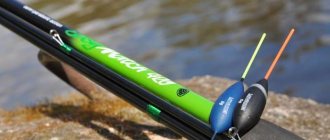Time and place for catching catfish from the shore
The places where these predatory fish most often live in a given area are known to almost all fishermen who hunt for the bottom inhabitant of fresh water bodies. The main habitats of this fish are deep pools and holes in a quiet river, which are littered with bottom vegetation or snags.
The optimal time for catching catfish is mid-summer, July and early August, when the water is warm and the fish swim closer to the surface of the water. It is optimal to go fishing for this giant in the evening or at night. Places are chosen - a hole or a pool, no more than a meter deep.
Peculiarities of catfish biting by season
In order for catfish fishing from the shore to be successful, it is necessary to take into account the characteristics of fishing according to the season:
- At the very beginning of April, the catfish emerges from its winter hibernation and begins to gain weight intensively. During this period of time, it is optimal to fish with a donka. In the second half of the month, fishing is carried out using a spinning rod.
- At the beginning of May, the fish go to spawn and the hunting for catfish temporarily stops, although by the end of the month fishing resumes again, but with fishing rods.
- During the summer months, catfish hunting is intense, most of it from the shore and using fishing rods.
- Starting from September, fish migrate and therefore the intensity of fishing decreases.
- From November to March fishing stops.
Catching catfish in October
Home > Autumn fishing > Catching catfish in October
With the arrival of autumn, the heat-loving catfish begins to flock together in order to occupy places for wintering. Many fishermen mistakenly believe that catfish hibernate as the water gets colder, and this happens immediately after the end of Indian summer. On the contrary, large catfish can be successfully caught not only in October, but even in early November in good weather. In autumn, catfish feed only on windless, warm and quiet days. Cold autumn rains do not in any way contribute to a good bite. To successfully catch catfish in October, you need to choose the right section of the river.
It will be much easier if the wintering pits of the fish are known in advance. But, firstly, fishing in them is considered poaching, and secondly, as soon as the catfish falls into such pits, it stops feeding.
Knowing where the wintering pit is located is also necessary for catching catfish in October in order to be able to watch for fish on the approaches to the pits. In rivers, catfish at this time of year always rise into the pits against the current. That is why there is no point in looking for it on the numerous deep rifts above these holes (as they do in the summer). The best place for hunting catfish during this period is the section of the river between the river bed and quiet coastal holes with a reverse flow. No less effective are the pits located in numerous river “breakthroughs”, “volozhkas” and “breakthroughs”.
If there are no holes nearby, then the lower edge of the riverbed is perfect for catching catfish in October, but only where it sharply goes to the side. Such a place can be identified by a weakening of the current, an increase in depth, and a break in the high bank. It’s great if there is a deep place with a moderate reverse current. If the current is smooth over a large section of the river, then it is necessary to look for wintering holes in the riverbed and fish in it.
The place has been chosen, now I want to see the long-awaited bite. But there is no need to rush, because catching catfish in October, as in any other month, should take place in the rhythm of half-asleep, laziness and constant waiting. We must not forget about our own safety. For example, what should you do if, when fishing in a two-seater inflatable boat, a specimen weighing 50 kg is caught on the hook? Experienced fishermen will answer that you can’t do that. To catch catfish in October, it is best to rent a boat, or fish from the shore using gear designed for tuna.
To catch catfish in October, you need to prepare gear and bait. As for the latter, ordinary earthworms, shells, crayfish necks or live bait are ideal here. After this, it is necessary to measure the depth of the reservoir and examine the bottom topography. To do this, tie some weight to the rope and stretch it along the entire bottom. After studying the depth, you can easily determine the most advantageous fishing point at the most promising depth. After feeding, it is necessary to install a smaller feeder and leashes with hooks. From this moment, catfish fishing directly begins in October on the feeder. Here, not only a good bait, but also casting accuracy plays a huge role. To achieve the best result, you will have to get a little used to throwing the feeder. It is necessary to cast it as often as possible, periodically checking the condition of the bait and updating the bait.
Tackle for catching catfish from the shore
When choosing gear, the main selection criterion is the ability to withstand the largest possible loads, or more precisely the weight of the catfish. But as other experienced fishermen say, you should choose gear based on the expected catch.
Rod size, rod strength
The fishing rod must be strong - for example, a telescopic fishing rod with a large fish weight can fail while pulling the fish, but plug-in models can withstand it.
Regarding the size of the fishing rod, if you are fishing from the shore, it is optimal to take a rod of size 2.7 meters. With a longer or shorter length it will simply be inconvenient.
Coil
The reel is chosen on a metal base - you can choose either multiplier or inertia-free. But a lot depends on what type of fishing rod you choose.
fishing line
If you choose a fishing line, a minimum of 200 m is wound on the spool, with the size of the latter being 0.5 mm. As an option, instead of fishing line, many fishermen wind a strong, 0.3-0.6 mm thick cord that can withstand a tensile load of 35-60 kg.
Hooks
When choosing a hook and its size, the choice of the nozzle itself is taken into account, and there can be many options.
So, when catching a predator with live bait weighing from 30 to 100 grams, hooks are chosen with a caliber of 8-10 units. according to the international, European classification scale. When fishing from the shore, where the bait is worms, bird offal, then choose a hook gauge of 6.
Other equipment
Regarding other equipment, it is important to select Kevlar leashes on which the hooks are attached. Breaking load - vary from 40 to 150 kg.
Another option is a thick, synthetic fishing line with a diameter of 0.8-1.0 mm, although as such these predators are not particularly picky about their capture, so the thickness of the latter is not particularly important. The main thing is not to take a braided, less strong cord - the catfish will easily chew it through.
Types of bottom gear for catching catfish
When catching a freshwater predator with a donkey, choosing the right one is important. To do this, you will need a donkey, as with a fishing rod, but you can choose models without one.
Donka with a rod and a hook
If you catch catfish from the shore, the simplest donkey model will do, and this is what is recommended for novice fishermen. You can choose bottom tackle with a strong rod and reel that can withstand the weight of a large fish.
In this case, it is optimal to choose a fishing line from 0.5 to 1 mm, but to pull out a trophy fish, choose braided cords with a thickness of up to 0.8 mm. It is also important to choose strong hooks and sinkers, the weight of which, in the absence of a strong current, should be 100-150 grams.
The bait is used when catching catfish in areas of a reservoir with a strong current - the fishing line is attached to any reliable object located on the shore. For this purpose, it is optimal to use nylon cords to which a sinker is attached, as well as leashes with a diameter of 0.5-0.8 mm.
Let's celebrate! Regarding the weight of the sinker, it is selected based on the fishing activity, while the hook is mostly taken as single, less often double or triple, because it all depends on the size of the expected catch.
Bottom tackle without a rod
If you are fishing for predators in bodies of water with strong currents, use special gear that goes in a structure without a rod. This is the same trick - there is practically nothing sporty in this type of fishing, but the catch can be significant.
Catching catfish on donkeys at night
- pike;
- pike perch;
- perch;
- bream, etc.
As they say, the deeper it sits, the more difficult it is to get it. It is this statement that is closest to catching catfish. So how can you successfully and regularly catch large catfish?
Secondly, it is necessary to fish at the appropriate time of day, when these fish are most active and inclined to search for food.
Thirdly, it is necessary to catch catfish with the correct tackle and bait.
The key to all the above tasks is simple. It is better to catch this large fish in the channel pits (depressions) of the river at night using donkeys. These are the conditions that will help the fisherman return home with the desired catch!
If it is impossible to obtain the necessary information, you will have to:
• examine the bottom; • identify the deepest places with steep slopes.
Usually such depressions can be found at sharp turns of the river. Additional benefits include:
- clay bottom;
- relative purity of water;
- the presence of old massive snags protruding to the surface.
At the same time, the bottom, completely strewn with small fallen branches and overgrown with algae, does not in any way attract predators of the underwater depths. In addition, fishing in cluttered places is replete with snags, cliffs and other difficulties for the angler.
- a large catfish lies on the river bottom like a motionless log, not trying to move, not interested in baits and lures;
- small catfish walk throughout the river, reaching the coastal thickets, riffles, shoals, etc.
The behavioral characteristics of a given predator themselves determine the easiest path to its localization and capture in its permanent habitat. In addition, the largest specimens simply cannot be found in other places.
Catching catfish on donkeys
The use of this gear is due to several important reasons.
1. Large catfish is a very strong and massive fish, which is difficult to catch with a simple float rod. 2. Special conditions for catching catfish (depth, underwater snags, reverse currents, whirlpools) exclude the possibility of frequent casting and the use of gear with light loads.
Thus, an ordinary float tackle turns into a children's toy that does not cope with the assigned tasks and does not perform the functions assigned to it. In such a situation, it is advisable to use the fisherman’s “heavy” arsenal:
- spinning;
- donku;
- fishing rod for fishing from the bottom.
Donka is a fishing tackle equipped with a rigid rod of medium or short length. The tackle is complemented by a multiplier reel with the most rigid line or cord. It is not necessary to cast a donk for catfish far, but it is necessary to fight with strong fish (or hooks).
Hooks, naturally, are taken the largest, the sharpest, the highest quality (depending on the bait). The sinker, in turn, must ensure the immobility of the bait on the bottom and the sensitivity of the gear so that the angler can recognize the different stages of the bite.
- a bunch of large worms;
- dead crayfish;
- minced meat toothless;
- spoiled meat or fish;
- large sluggish baitfish;
- toads;
- cheese, etc.
All of these baits can be used as additional bait when fishing for catfish. However, special results are observed with the use of crayfish, because This food is included in the standard menu of river catfish.
It is recommended to install donks according to the following scheme:
- one - on the pit itself;
- two – in the lower parts of the underwater basin;
- one is at the gentle exit from the pit.
Another evening:
- a fire is lit on the shore;
- Donks are installed and firmly fixed;
- the brake mechanisms of the coils are adjusted;
- Sound or light alarms are installed so that in the darkness of the night (by the light of a fire or lantern) you do not miss the long-awaited bite.
In general, such fishing is more like hunting, which will not interest every beginner. Rarely will a fisherman want to spend several nights on the shore near a fire, waiting for a single bite that will result in a multi-kilogram catch.
In addition, fishing for trophy catfish is not complete without the personal qualities of the fisherman:
- perseverance;
- excerpts;
- self-discipline;
- the ability to set and achieve goals.
SsabbasS – Specially for Samodelki FISH
- How to feed a catfish fishing area
- How to be guaranteed to catch a catfish
How to make a donka for catfish with your own hands?
To make a donk on your own, you will need a strong fishing line with a diameter of 0.5-1 mm, hooks number 10-40, plus a heavy weight.
Step-by-step creation instructions look like this:
- At the very beginning, a sinker is attached to the fishing line, and already above it, at a distance of 30-40 cm, leashes are attached and, using a carabiner, this is attached to the main part with a carabiner.
- Next, take any homemade equipment - it can be made from any strong, available material. And here it is good because it allows you to hunt for catfish of any size.
- You need a fishing line - take a twine, twisted or braided, that can withstand a load of up to 30-35 kilograms, and here it is important not to skimp on its length, reeling out 100-150 meters.
- The weight can be bought either in a store or cast from lead in the shape you need - it is attached at a distance of 40-80 cm from the hook.
Good to know! Everything is quite simple and easy - if you have time and desire, you can assemble it yourself.
Choosing bait for catching catfish from the shore
For bait, you can use large insects, as well as small fish caught locally, meat - fresh or rotten. As many experts note, the best bait for predatory fish is the mussel, although live bait can also be a worthy replacement.
You can also catch the inhabitant of pits and dams with a frog, and you can get it easier than a mole cricket. An earthworm is also suitable for bait, but due to its small size, you will need a lot of them to catch.
Tactics for catching catfish from the shore
The tactics of catching catfish from the bank of a river or any other body of water are possible both with a rod and without a rod - the main thing is that the fish is able to grab the bait.
Ideally, if you position yourself near a hole where catfish live:
- Fishing with a rod. To do this, it is worth installing the stand at the very beginning and loosening the friction-type brake in the coil, then adjusting the signal beacon.
- Fishing without a rod. Here the bottom is attached to an ordinary branch of the nearest tree, or a support is driven into the bank and the rod is fixed to it.
Note! The optimal time for fishing for catfish is evening or night. And if you don’t catch anything, it may already be morning, and the bite as such is over.
How to catch catfish?
Many fishermen say that the most rewarding part of catching catfish is landing it on the shore - here it is important to observe not just patience, but also a certain amount of caution. After the catfish grabs the bait and catches it on the hook, it is worth tiring and weakening the fish.
If the fish has sunk to the bottom, to “lift” it, you should sharply knock on the rod, with a stone or with any handy stick. This fish is terrified of sharp sounds and knocking and, accordingly, it will quickly rise to the surface of the water.
Let's celebrate! To avoid injuries, it is best to wear canvas gloves on your hands so as not to cut yourself on the fishing line. And when the catfish gets tired in this way, it will turn its belly up. Then you can pull it to the shore, where the catfish will no longer be able to go under water. Already near the shore, they hook it under the gills with a hook and pull it ashore.
Let's learn to nod correctly.
You can also hear or read the opinion that the sound of a quok imitates something or someone. I am still inclined to believe that the sound that the kwok makes acts as an irritant. And the fish rises from the bottom to the surface to see what is happening. Making the correct kwok sound is not difficult, but it still doesn’t require much practice. The hand and forearm should be involved in this process. The involvement of the shoulder itself should be minimal. The fisherman’s task is to gently drive the kwok nickel under the surface of the water, increasing the speed of the heel and bringing it to the surface. The movements are not difficult, but require training until they become automatic.
The shape of a nickel is kwoka.
The nickel quok is very important. Its shape determines the ease of use of the instrument and the tonality of the sound. Conventionally, nickels can be divided into concave, convex and curved, or as they are called surf. I find it convenient to nod with concave heels in any weather. It doesn't matter whether it's calm or wave.
CONCAVED PITCH.
The convex penny is comfortable in calm weather.
Thanks to it, the sound turns out to be more sonorous and louder. Kwok with a convex heel
Surf quoks are located approximately in the middle, between concave and convex. They make sound quite easily, and the hand does not get tired even during long fishing trips.
SURF KWOK
The sound of a kwok is another huge myth. Very often, novice fishermen are told that a certain fish works much better than others. Or he is only able to lift large catfish. Personally, I have come to the conclusion that any quok that can make a sound can raise a catfish.
In fact, there is not and cannot be any precise conclusion that this is right and this is not. Each angler works with the nook in his own way and there is no clear formula for correct nooking.
Kwok work.
I most often use a series of 5-6 hits, after which I pause for about 15-20 seconds. Sometimes I use quite long series of blows. And other times I do the opposite – long pauses.
Rods.
I prefer to use short but powerful rods in sizes 1.8 and up to 2.2 meters. And I use a spinning reel with cord. In my opinion, two rods are the golden mean. It is very convenient to differentiate between the two rods based on the depth of your baits. If I am fishing above a depth of 10 meters, then I lower the first nozzle 3 m, and the second about 6 meters from the surface of the water. Plus, my baits differ in composition and I can quickly switch to the one that the catfish prefers today.
Of course, you can talk about catching catfish with kwok for a very long time and it cannot fit into the size of one article. But in this one I promised to tell you only about the basics. I hope I succeeded! However, the topic of catfish fishing does not end here and there will definitely be a continuation. I can find out whether you liked the article or not from your comments. The comment section is open without any registration.
Just below you can enjoy a video of catching a catfish with a kwok.
Reviews from fishermen
I caught this giant in the evening, from a boat - I used the simplest nylon cord and hook 10, a hook of bait. So I took their bait with a cabbage fish and a green worm - I was pleased with the catch. Grade:
Alexander, 33 years old
Fished on the Volga for catfish - entertaining and successful, at the beginning of September. Early in the morning we threw gear into the creeks, caught frogs, and in the evening we caught catfish using them. We were happy with the catch - we caught 2 large catfish worth 15 kilos, and then 3 small ones, each weighing a kilo. Grade:
Igor
I can safely call myself an expert in catching catfish - my grandfather and my father caught them in our old creek. I advise all beginners to fish with rotten meat and fresh frogs, and pull with a strong line. I actually get the hooks from our blacksmith - he forges them for me to order. This year in the spring I have already caught 50 kilos of catfish - the main thing is complementary food and a strong hook. Grade:
Ivan
I always fished for catfish in a shallow area - a friend of mine suggested this to me. Here there is less resistance from the fish, and even with a flat, gently sloping bottom, everything is clearly visible. As for bait, it is best to fish with live bait, which is taken from the same body of water where the catfish itself lives. Grade:
Oleg
For the first time this year I caught catfish - using dead and slightly spoiled fish. But I’ll tell you from myself – the smell is still the same, and instead of fishing line you should take not 0.8 fishing line, but a strong synthetic cord. A friend suggested the place to me - it was with him that we pulled out a huge catfish from a pool on the Volga. Grade:
Nikolai
Let's celebrate! The key to successful catfishing consists of several components. At the very beginning it is fishing in the right place, the second is fishing at the right time of day, i.e. in the evening or at night. And, of course, you first need to select the gear, and the rest is a matter of skill and technique.
Tackle
Classic gear for catching catfish with kwok is considered primitive; it is still used today, but extremely rarely. Still, remnants of the past remain and you can see fishermen on the pond equipped with a reel, a very thick fishing line is wound around it, at the end of which there is a large hook and a heavy sinker, about 120 grams
.
But sport fishing is gradually gaining momentum, and it is becoming increasingly difficult to see fishermen with primitive gear on the Lower Volga and Oka, even in 2021 there were already very few of them. Too many aesthetes who prefer fighting fish using a spinning rod and a baitcasting reel are gradually replacing the “veterans who drag catfish by the rope.”
Catching catfish using kwok can only be done from a boat.
. Let's not delve into the details of antediluvian gear, but immediately move on to a clear list of what is needed for such fishing and what modern equipment for catching catfish with a kwok should look like.
- Spinning
– with certain skills you can do without it, but it is still recommended to use powerful fishing rods, the reliability of which has been proven over years of experience. - Reel
- a multiplier is best; it must be powerful and have the highest possible gear ratio. - The fishing line
must be very strong (minimum breaking weight - 30 kg), about 65 meters long + depth at the fishing site. - Sinker
- weight depends on fishing conditions (often 120 - 250 grams). But you should not use a sinker that is too heavy, as problems may arise when fishing. - Hook
– its size directly depends on the size of the fish.
Now let's talk a little about making equipment:
- Take a cone-shaped sinker and thread a steel wire through it.
- Form an eye on both ends of the wire.
- The main line must be tied to one eye, and the leash to the second.
Choosing a quok
The choice of quok should be given special attention, since it is one of the most important elements of equipment. There are many different forms and types of such gear, but their essence has always remained the same.
It is as follows:
- Air is captured by the cup when immersed in water;
- And when leaving the water, this air bursts to the surface, emitting that very cherished sound.
The difference between a quok can consist of several parameters: the diameter of the cup (which is also called the snout), the shape of the bend and its angle and, of course, the dimensions. But only one difference is significant - the size of the patch. The larger it is, the more effective the sound, but the greater the load on the fisherman’s hands and fatigue will come sooner.
Very often you can find products on store shelves that are very expensive, but their quality is not much different from budget models. As practice shows, it is the budget options that provide a good catch, and catching catfish with a quok with expensive gear turns into a waste of money.
Choosing a quok is a very important task that can take a lot of time. If you use only one model, then the likelihood of catching a trophy is minimized. You need to search, choose and experiment, otherwise nothing will work. I recommend that you go to watch the video.
